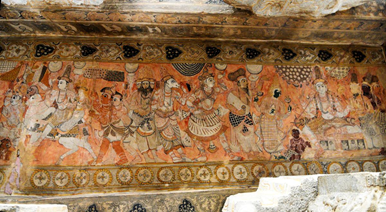

7th May 2022 (7 Topics)
Context
Lepakshi temple is located in Andhra Pradesh, built during the era of Vijayanagara Empire.
About
About Lepakshi Temple Complex:
- Lepakshi is famous for its three shrines, which are dedicated to Lord Vishnu, Lord Shiva and Lord Veerabhadra.
- The Veerabhadra Temple was constructed by two brothers, Viranna and Virupanna.
- The temple is built in the Vijayanagar architectural style and has beautiful sculptures adorning the walls.
- There is a huge Nandi bull made from a single granite stone.
- Lepakshi has many murals from the Vijayanagar Era and the famous sculpture of the snake on the Nagalinga.
- The original structure is said to have been built by Sage Agastya, and finds mention in the Skanda Purana as one of the 108 Saivaite pilgrimage centres of ancient India.
- The entire temple complex was believed to be re-built by Virupanna, and his brother Veeranna under the rule of Vijayanagara king Achyuta Devaraya.
- The main shrine, the 70-pillared nrutya mantapa, the detailed and beautiful carvings on them depicts gods and artistes playing musical instruments and dancers in various poses and mudras.
- The high ceiling is filled with long panels of fresco paintings.

- The high ceiling is filled with long panels of fresco paintings.
Nagalinga

Fresco Paintings
The Ramayana link
- The name of the place itself is linked with the Ramayana.
- Legend has it that Jatayu fell at this spot after Ravana cut its wings when he tried to prevent Sita’s abduction.
- Rama stumbled upon the bird when searching for Sita.
- After the injured bird narrated what had happened, Rama coaxed him to rise again, “le, pakshi” (rise, bird in Telugu).
|
The Age of Vijaya Nagara (1336-1647) AD :
|
More Articles



